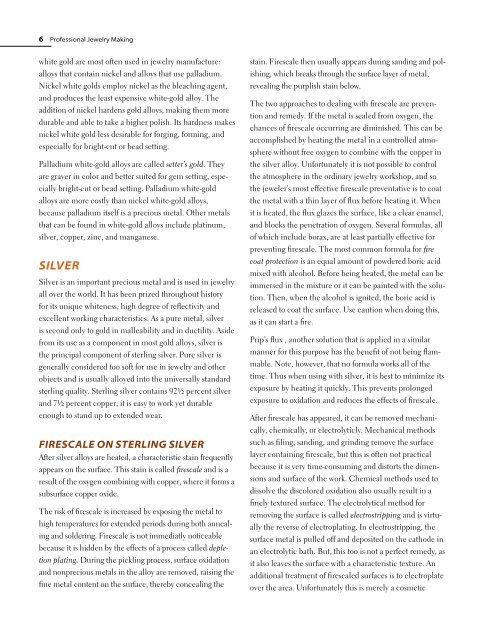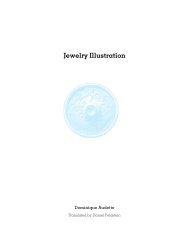Professional Jewelry Making - Brynmorgen Press
Professional Jewelry Making - Brynmorgen Press
Professional Jewelry Making - Brynmorgen Press
Create successful ePaper yourself
Turn your PDF publications into a flip-book with our unique Google optimized e-Paper software.
6 <strong>Professional</strong> <strong>Jewelry</strong> <strong>Making</strong><br />
white gold are most often used in jewelry manufacture:<br />
alloys that contain nickel and alloys that use palladium.<br />
Nickel white golds employ nickel as the bleaching agent,<br />
and produces the least expensive white-gold alloy. The<br />
addition of nickel hardens gold alloys, making them more<br />
durable and able to take a higher polish. Its hardness makes<br />
nickel white gold less desirable for forging, forming, and<br />
especially for bright-cut or bead setting.<br />
Palladium white-gold alloys are called setter’s gold. They<br />
are grayer in color and better suited for gem setting, especially<br />
bright-cut or bead setting. Palladium white-gold<br />
alloys are more costly than nickel white-gold alloys,<br />
because palladium itself is a precious metal. Other metals<br />
that can be found in white-gold alloys include platinum,<br />
silver, copper, zinc, and manganese.<br />
sIlVer<br />
Silver is an important precious metal and is used in jewelry<br />
all over the world. It has been prized throughout history<br />
for its unique whiteness, high degree of reflectivity and<br />
excellent working characteristics. As a pure metal, silver<br />
is second only to gold in malleability and in ductility. Aside<br />
from its use as a component in most gold alloys, silver is<br />
the principal component of sterling silver. Pure silver is<br />
generally considered too soft for use in jewelry and other<br />
objects and is usually alloyed into the universally standard<br />
sterling quality. Sterling silver contains 92½ percent silver<br />
and 7½ percent copper; it is easy to work yet durable<br />
enough to stand up to extended wear.<br />
fIrescAle on sterlIng sIlVer<br />
After silver alloys are heated, a characteristic stain frequently<br />
appears on the surface. This stain is called firescale and is a<br />
result of the oxygen combining with copper, where it forms a<br />
subsurface copper oxide.<br />
The risk of firescale is increased by exposing the metal to<br />
high temperatures for extended periods during both annealing<br />
and soldering. Firescale is not immediatly noticeable<br />
because it is hidden by the effects of a process called depletion<br />
plating. During the pickling process, surface oxidation<br />
and nonprecious metals in the alloy are removed, raising the<br />
fine metal content on the surface, thereby concealing the<br />
stain. Firescale then usually appears during sanding and polishing,<br />
which breaks through the surface layer of metal,<br />
revealing the purplish stain below.<br />
The two approaches to dealing with firescale are prevention<br />
and remedy. If the metal is sealed from oxygen, the<br />
chances of firescale occurring are diminished. This can be<br />
accomplished by heating the metal in a controlled atmosphere<br />
without free oxygen to combine with the copper in<br />
the silver alloy. Unfortunately it is not possible to control<br />
the atmosphere in the ordinary jewelry workshop, and so<br />
the jeweler’s most effective firescale preventative is to coat<br />
the metal with a thin layer of flux before heating it. When<br />
it is heated, the flux glazes the surface, like a clear enamel,<br />
and blocks the penetration of oxygen. Several formulas, all<br />
of which include borax, are at least partially effective for<br />
preventing firescale. The most common formula for fire<br />
coat protection is an equal amount of powdered boric acid<br />
mixed with alcohol. Before being heated, the metal can be<br />
immersed in the mixture or it can be painted with the solution.<br />
Then, when the alcohol is ignited, the boric acid is<br />
released to coat the surface. Use caution when doing this,<br />
as it can start a fire.<br />
Prip’s flux , another solution that is applied in a similar<br />
manner for this purpose has the benefit of not being flammable.<br />
Note, however, that no formula works all of the<br />
time. Thus when using with silver, it is best to minimize its<br />
exposure by heating it quickly. This prevents prolonged<br />
exposure to oxidation and reduces the effects of firescale.<br />
After firescale has appeared, it can be removed mechanically,<br />
chemically, or electrolyticly. Mechanical methods<br />
such as filing, sanding, and grinding remove the surface<br />
layer containing firescale, but this is often not practical<br />
because it is very time-consuming and distorts the dimensions<br />
and surface of the work. Chemical methods used to<br />
dissolve the discolored oxidation also usually result in a<br />
finely textured surface. The electrolytical method for<br />
removing the surface is called electrostripping and is virtually<br />
the reverse of electroplating. In electrostripping, the<br />
surface metal is pulled off and deposited on the cathode in<br />
an electrolytic bath. But, this too is not a perfect remedy, as<br />
it also leaves the surface with a characteristic texture. An<br />
additional treatment of firescaled surfaces is to electroplate<br />
over the area. Unfortunately this is merely a cosmetic




